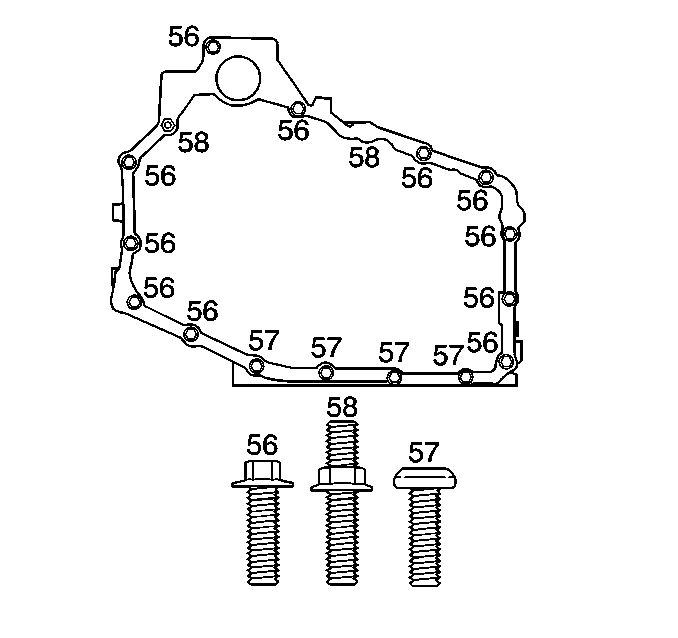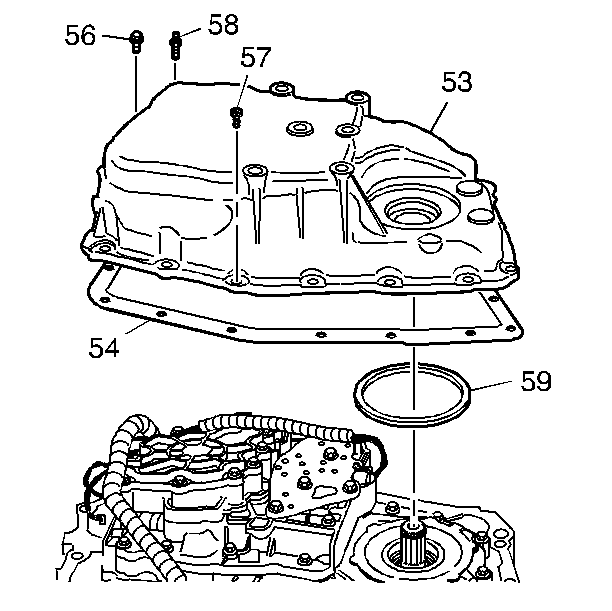Removal Procedure
- Disconnect the negative battery ground cable. Refer to Battery Negative Cable Disconnection and Connection in Engine Electrical.
- Remove the throttle body air inlet duct. Refer to Air Cleaner Inlet Duct Replacement in Engine Controls.
- Install the engine support fixture. Refer to Engine Support Fixture
- Remove the engine mount strut. Refer to Engine Mount Strut Replacement in Engine Mechanical.
- Raise and support the vehicle. Refer to Lifting and Jacking the Vehicle in General Information.
- Remove the left front wheel. Refer to Tire and Wheel Removal and Installation in Tires and Wheels.
- Remove the left engine splash shield. Refer to Engine Splash Shield Replacement in Body Front End.
- Remove the stabilizer shaft links from the lower control arms. Refer to Stabilizer Shaft Link Replacement in Front Suspension.
- Remove the left tie rod end from the steering knuckle. Refer to Steering Knuckle Replacement in Front Suspension.
- Remove the wheel speed sensor harness connector. Refer Wheel Speed Sensor Jumper Harness Replacement (Front) in ABS.
- Remove the left lower ball joint from the left steering knuckle. Refer to Steering Knuckle Replacement in Front Suspension.
- Disconnect the left drive axle from the transaxle. Refer to Wheel Drive Shaft Replacement in Drive Axle.
- Secure the drive axle to the steering knuckle/strut.
- Remove the pinch bolt at the intermediate steering shaft. Refer to Intermediate Steering Shaft Replacement in Steering Wheel and Column.
- Remove the intermediate shaft from the steering gear. Refer to Intermediate Steering Shaft Replacement in Steering Wheel and Column.
- Disconnect the three-way catalytic converter pipe to the right (rear) exhaust manifold. Refer to Catalytic Converter Replacement in Engine Exhaust.
- Support the right side of the frame with jackstands.
- Support the left side of the frame with jackstands.
- Remove the transaxle mount bracket. Refer to Transmission Mount Bracket Replacement .
- Remove the transaxle mount. Refer to Transmission Mount Replacement .
- Loosen the engine mount lower nuts. Refer to Engine Mount Replacement in Engine Mechanical.
- Loosen the right side frame to body bolts. Refer to Frame Repair in Frame and Underbody.
- Remove the left side frame to body bolts. Refer to Frame Repair in Frame and Underbody.
- Adjust the jackstand to the lower left side of the frame.
- Position the drain pan under the transaxle.
- Remove the wiring harness connector.
- Remove the case side cover bolts (56-58).
- Remove the case side cover pan (53).
- Remove the case side cover gasket (54).
- Remove the case side cover inner gasket (59).
- Inspect the case side cover (53) for the following conditions:
- Inspect the case side cover gasket (54) and case side cover inner gasket (59) for damage. The gaskets are reusable if they are NOT damaged.
- Clean the case side cover.
- Clean the case side cover gasket surfaces.
Caution: Before servicing any electrical component, the ignition and start switch must be in the OFF or LOCK position and all electrical loads must be OFF, unless instructed otherwise in these procedures. If a tool or equipment could easily come in contact with a live exposed electrical terminal, also disconnect the negative battery cable. Failure to follow these precautions may cause personal injury and/or damage to the vehicle or its components.
Caution: Failure to disconnect the intermediate shaft from the rack and pinion stub shaft can result in damage to the steering gear and/or damage to the intermediate shaft. This damage may cause loss of steering control which could result in personal injury.



| • | Damaged or porous gasket sealing surfaces |
| • | Damaged or porous casting surfaces |
| • | Damaged or stripped bolt holes |
Installation Procedure
- Install the case side cover inner gasket (59).
- Install the case side cover gasket (54).
- Install the case side cover pan (53).
- Install the case side cover bolts (56-58).
- Remove the drain pan from under the transaxle.
- Install the wiring harness connector.
- Adjust the jackstand to raise the left side of the frame.
- Install the left side frame to body bolts. Refer to Frame Repair in Frame and Underbody.
- Install the right side frame to body bolts. Refer to Frame Repair in Frame and Underbody.
- Install the engine mount lower nuts. Refer to Engine Mount Replacement in Engine Mechanical.
- Install the transaxle mount. Refer to Transmission Mount Replacement .
- Install the transaxle mount bracket. Refer to Transmission Mount Bracket Replacement .
- Remove the jackstand support from the right side of the frame.
- Remove the jackstand support from the left side of the frame.
- Connect the three-way catalytic converter pipe to the right (rear) exhaust manifold. Refer to Catalytic Converter Replacement in Engine Exhaust.
- Install the intermediate shaft to the steering gear. Refer to Intermediate Steering Shaft Replacement in Steering Wheel and Column.
- Install the pinch bolt at the intermediate steering shaft. Refer to Intermediate Steering Shaft Replacement in Steering Wheel and Column.
- Install the left drive axle to the transaxle. Refer to Wheel Drive Shaft Replacement in Drive Axle.
- Install the left lower ball joint to the left steering knuckle. Refer to Steering Knuckle Replacement in Front Suspension.
- Install the wheel speed sensor harness connector. Refer to Wheel Speed Sensor Jumper Harness Replacement (Front) in ABS.
- Install the left tie rod end to the steering knuckle. Refer to Steering Knuckle Replacement in Front Suspension.
- Install the stabilizer shaft links to the lower control arms. Refer to Stabilizer Shaft Link Replacement in Front Suspension.
- Install the left engine splash shield. Refer to Engine Splash Shield Replacement in Body Front End.
- Install the left front wheel. Refer to Tire and Wheel Removal and Installation in Tires and Wheels.
- Lower the vehicle.
- Install the engine mount strut. Refer to Engine Mount Strut Replacement in Engine Mechanical.
- Remove the engine support fixture. Refer to Engine Support Fixture .
- Remove the throttle body air inlet duct. Refer to Air Cleaner Inlet Duct Replacement in Engine Controls.
- Connect the negative battery ground cable. Refer to Battery Negative Cable Disconnection and Connection in Engine Electrical.
- Adjust the fluid level. Refer to the following procedures in Maintenance and Lubrication:
- Inspect for fluid leaks.


Notice: Use the correct fastener in the correct location. Replacement fasteners must be the correct part number for that application. Fasteners requiring replacement or fasteners requiring the use of thread locking compound or sealant are identified in the service procedure. Do not use paints, lubricants, or corrosion inhibitors on fasteners or fastener joint surfaces unless specified. These coatings affect fastener torque and joint clamping force and may damage the fastener. Use the correct tightening sequence and specifications when installing fasteners in order to avoid damage to parts and systems.
Tighten
Tighten the case side cover bolts (56-58) to 25 N·m
(18 lb ft).
Caution: When installing the intermediate shaft make sure that the shaft is seated prior to pinch bolt installation. If the pinch bolt is inserted into the coupling before shaft installation, the two mating shafts may disengage. Disengagement of the two mating shafts will cause loss of steering control which could result in personal injury.
Notice: Do NOT overfill the transaxle. The overfilling of the transaxle causes foaming, loss of fluid, shift complaints, and possible damage to the transaxle.
